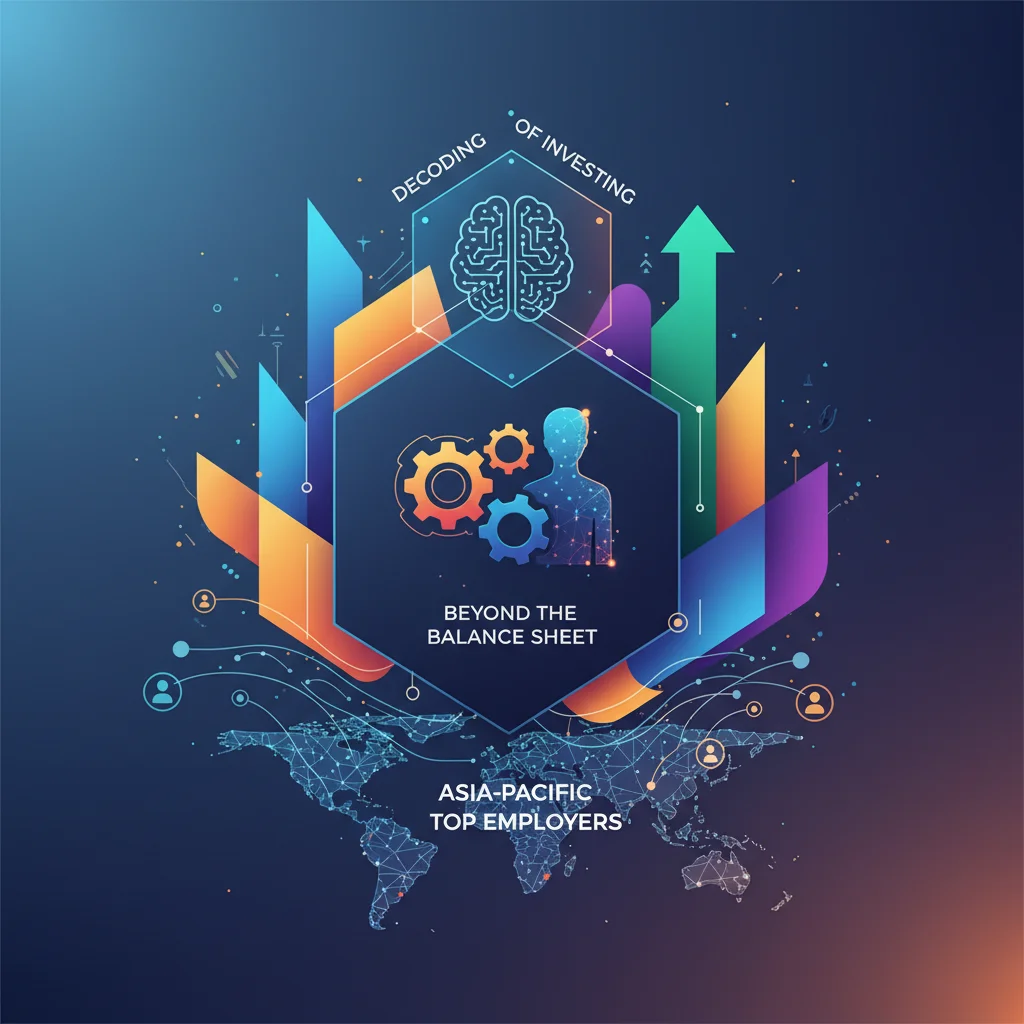
Beyond the Balance Sheet: Decoding Asia-Pacific’s Top Employers and the Future of Investing
In the intricate world of finance and investing, traditional metrics like P/E ratios and revenue growth have long dominated the conversation. But what if the most powerful leading indicator of a company’s future success isn’t found on its balance sheet, but in the morale of its workforce? A groundbreaking report from the Financial Times and Statista is shedding light on this very question, revealing the companies that employees value most across the dynamic Asia-Pacific (APAC) region.
By surveying over 50,000 employees, this comprehensive study does more than just create a leaderboard of desirable workplaces. It paints a vivid picture of the shifting priorities, deep-seated challenges, and immense opportunities shaping the future of work and, consequently, the region’s economy. For astute investors, finance professionals, and business leaders, these insights into human capital are not just ‘soft’ data—they are critical intelligence for navigating the complexities of the modern stock market and global economics.
This report uncovers a fascinating tapestry of trends: from Japan’s corporate giants looking overseas to combat demographic decline, to a critical talent shortage in the high-stakes semiconductor industry, and from India’s massive push to reskill its workforce for a digital future to the unique perks offered by Korean banks to fend off fintech rivals. Let’s delve deeper into these trends and explore what they signal for the future of business and investment in APAC.
The New Corporate Battleground: Key Workforce Trends Across APAC
The post-pandemic world has fundamentally altered the employer-employee relationship. Today’s top talent demands more than just a competitive salary; they seek purpose, flexibility, a supportive culture, and opportunities for growth. The companies that understand this are not only winning the war for talent but are also building more resilient, innovative, and ultimately, more profitable organizations. The FT/Statista report highlights several key national narratives that exemplify this new reality.
Below is a summary of the distinct challenges and strategic responses observed in key Asia-Pacific economies, each presenting unique risks and opportunities for investors.
| Country/Sector | Core Challenge | Strategic Response & Market Implications |
|---|---|---|
| Japan | Aging population, shrinking domestic workforce, and rigid corporate structures. | Increased overseas hiring, M&A activity abroad, and a slow shift towards more flexible work cultures. This signals potential growth for global recruitment firms and challenges for domestically-focused Japanese companies. |
| Semiconductor Industry | A severe global shortage of highly specialized engineering and design talent, exacerbated by geopolitical tensions. | Massive investment in education partnerships, talent poaching, and government subsidies. This talent bottleneck is a major risk factor for the entire tech sector and a key variable in trading semiconductor stocks. |
| India | A vast, young population (“demographic dividend”) that requires significant upskilling to meet the demands of the digital economy. | Large-scale government and corporate reskilling initiatives, particularly in IT, financial technology, and AI. This creates a booming EdTech market and a pipeline of talent for global tech firms. |
| South Korea | Traditional banking institutions facing intense competition for tech talent from nimble fintech and “neobank” startups. | Offering unprecedented perks, high salaries, and improved work-life balance to attract and retain digital experts. The outcome of this battle will determine the future landscape of Korean finance. |
| China | Heavy reliance on a vulnerable class of factory gig laborers who lack job security and social safety nets. | Growing social and regulatory pressure to improve worker protections. This poses a risk to the low-cost manufacturing model and could impact supply chain stability for global corporations. |
Japan’s Outward Gaze: A Necessary Pivot for Survival
For decades, Japan Inc. has been a symbol of a homogenous, lifelong employment system. However, faced with one of the world’s most rapidly aging populations, this model is no longer sustainable. The report highlights a crucial pivot: Japanese companies are increasingly looking beyond their borders for talent and growth. This isn’t just about hiring foreign workers for domestic roles; it’s about acquiring foreign companies and establishing a significant global footprint. For investors, this trend suggests that the future growth of many blue-chip Japanese stocks on the Nikkei will be determined less by the domestic economy and more by their success in international markets.
The Driving Test Backlog: A Surprising Lesson in Economic Efficiency and Financial Systems
The Chipmakers’ Conundrum: A Talent Shortage with Global Consequences
The semiconductor industry is the bedrock of the modern digital world, from smartphones to AI data centers. The report underscores a critical vulnerability: a severe shortage of skilled talent. This is not just a human resources issue; it’s a geopolitical one. As nations vie for technological supremacy, the ability to design and manufacture advanced chips is paramount. The talent crunch directly impacts production timelines, innovation, and national security. For those involved in the stock market, the talent pipeline of companies like TSMC, Samsung, and Nvidia is as important a metric as their capital expenditure. A company that successfully secures and nurtures talent will have a decisive competitive edge for the next decade.
India’s Reskilling Revolution: Fueling the Next Tech Boom
While Japan faces a demographic deficit, India is on the cusp of a demographic dividend. With a massive youth population, the nation’s greatest challenge and opportunity is education and reskilling. The government and private sector are pouring resources into training workers for high-demand fields like cloud computing, data science, and even emerging areas like blockchain development. This national effort is creating one of the world’s largest pools of tech talent, making India an increasingly vital hub for global corporations. This trend presents a dual investment opportunity: first, in the burgeoning EdTech companies facilitating this reskilling, and second, in the Indian IT and fintech firms that will leverage this human capital to innovate and scale.
Korean Banks vs. Fintechs: A High-Stakes Battle for Brainpower
Nowhere is the clash between legacy and disruption more apparent than in South Korea’s financial technology sector. Traditional, conservative banks are in a fierce struggle with agile and innovative fintech startups for top-tier software engineers, data scientists, and product managers. To compete, these established institutions are being forced to reinvent their corporate culture, offering Silicon Valley-style perks, flexible work arrangements, and massive signing bonuses. As one of the most digitally advanced societies, the outcome of this talent war in Korea will be a bellwether for the global banking industry. Can the old guard adapt quickly enough, or will the future of finance be dictated by the newcomers who have built their organizations around attracting the best digital talent from day one? The answer will have profound implications for banking stocks and the broader financial services market.
Automation and Atypical Work: The Twin Challenges on the Horizon
Beyond the competition for high-skilled workers, the report also touches upon two powerful, disruptive forces at the other end of the labor spectrum: automation and the gig economy.
The Inevitable Rise of Automation
The threat of automation to jobs like truck and taxi driving is a well-documented concern. This isn’t a distant future; it’s a present-day reality that is reshaping logistics, transportation, and urban mobility. This technological shift presents a classic Schumpeterian “creative destruction” scenario. While it threatens to displace millions of workers, it also creates enormous opportunities for investing in companies developing autonomous driving technology, AI-powered logistics platforms, and the new infrastructure required to support them. The key societal challenge will be managing the transition and retraining the affected workforce for the jobs of tomorrow.
China’s Precarious Gig Labor
The report’s mention of China’s vulnerable factory gig laborers highlights a critical, often overlooked, aspect of the global supply chain. Many of the world’s goods are produced through a system that relies on temporary workers who lack the security, benefits, and rights of full-time employees. This model, while cost-effective, introduces significant fragility into the system. Regulatory crackdowns, labor unrest, or a shift in worker sentiment could lead to sudden disruptions and cost increases. According to the analysis, companies and investors with heavy exposure to this manufacturing model must factor in this social and political risk. A sustainable supply chain is not just about logistics and efficiency; it’s also about the stability and well-being of its human components.
Beyond the Boarding Pass: Ryanair's Digital Gambit and Its Ripple Effect on Finance and Investing
Conclusion: Human Capital as the Ultimate Asset
The Financial Times and Statista’s report on Asia-Pacific’s best employers is far more than a corporate popularity contest. It is a vital piece of economic intelligence that offers a roadmap to the future of the region’s markets. It demonstrates that a company’s greatest asset is its people, and its ability to foster a positive, supportive, and dynamic work environment is a powerful predictor of its long-term success.
For business leaders, the message is clear: culture is strategy. Investing in your employees is the most critical investment you can make. For investors and finance professionals, the takeaway is equally profound: look beyond the numbers. The companies that top these “Best Employer” lists are often the same ones that will deliver sustainable, long-term value to shareholders. In the complex and rapidly evolving global economy, understanding the landscape of human capital is no longer optional—it is the key to unlocking true insight and making smarter, more informed investment decisions.
